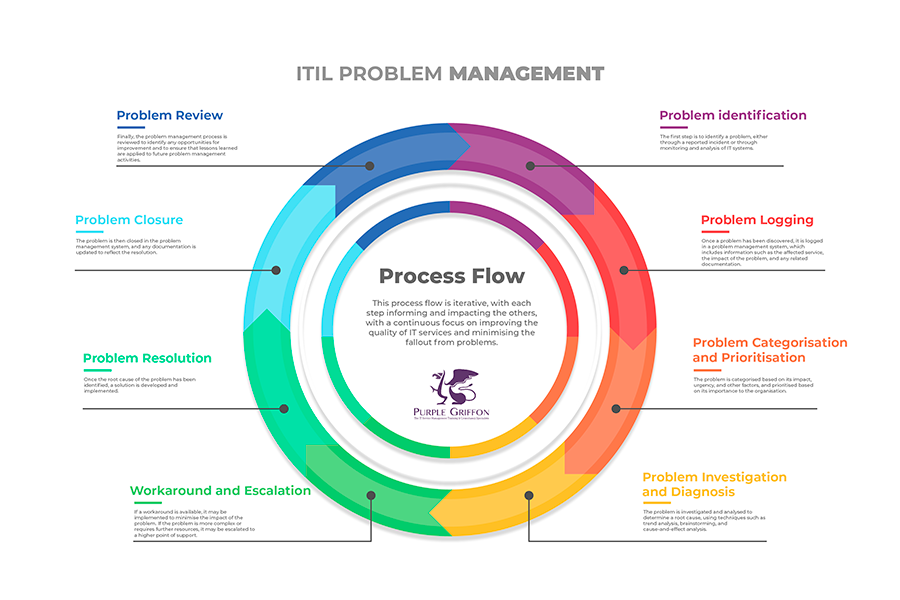Welcome to this post on ITIL Problem Management! In the modern age of technology, organisations are heavily dependent on information technology (IT) to efficiently maintain day to day activities.
However, with this dependence on IT comes the risk of facing problems and issues that may disrupt operations and lead to downtime. This is where the importance of ITIL problem management comes in.
ITIL, or Information Technology Infrastructure Library, is a framework for IT service management that provides guidelines and best practices for the design, delivery, and maintenance of IT services.
ITIL problem management is one of the key processes that make up this framework, and focuses on identifying, analysing, and resolving problems that affect IT services.
In this post, we'll take a closer look at ITIL problem management, including its importance, key activities, and the benefits.
Whether you're an IT professional looking to improve your organisation's problem management processes or a business owner seeking to better understand the role of ITIL in IT service management, this post will provide valuable insights and information.
(Before we continue click here if you are interested in our ITIL® 4 Practitioner: Problem Management Training Course).
- What is a problem in ITIL4
- What is Problem Management in ITIL4
- Why is ITIL Problem Management so Important?
- What is the Process Flow of Problem Management?
- What are the Role and Responsibilities of Problem Management?
- What is the Difference Between Problem and Incident Management?
- What Techniques Can be Used to Manage Problems in ITIL?
- How Does Problem Management Relate to Other Important Practises?
- What KPIs Should You Track?
- Where Can You Learn More?
- ITIL 4: Monitor, Support and Fulfil
- Final Notes on ITIL Problem Management
What is a Problem in ITIL4?
In ITIL 4, a problem is defined as the cause of one or more incidents. It is an underlying concern that, when resolved, can prevent incidents from occurring or recurring in the future.
A problem is the underlying root cause of an incident, which is covered under a separate practice, although as we will explain, the two are closely related.
What is Problem Management in ITIL4?
In ITIL 4, problem management is a process that aims to detect and remove the root cause of problems that affect IT services.
It involves investigating and analysing incidents, identifying underlying difficulties, and implementing solutions to prevent their recurrence.
The goal of problem management is to reduce the impact of incidents on the organisation and improve the overall integrity of IT services.

Why is ITIL Problem Management so Important?
ITIL problem management is important for several reasons. First, it helps to prevent those recurring incidents and minimize their impact.
By identifying and eliminating the root cause of problems, problem management can reduce downtime, improve service availability, and increase customer satisfaction.
Second, problem management can help to improve the general quality of IT services by identifying prospects for improvement and implementing solutions to tackle them.
This can lead to more efficient and effective service delivery, as well as better coalition between IT services and business objectives.
Third, problem management is an important part of ITIL's service lifecycle, which emphasizes the importance of continuous improvement.
By continually analysing and improving problem management processes, organisations can ensure that they are providing the best possible service to their customers.
Overall, ITIL problem management is a critical element of IT service management, helping organisations to deliver high-quality services that meet the needs of their customers and support their business objectives.
What is the Process Flow of Problem Management for ITIL?
The process flow of problem management in ITIL 4 typically consists of the following steps:
- Problem Identification: The first step is to identify a problem, either through a reported incident or through monitoring and analysis of IT systems.
- Problem Logging: Once a problem has been discovered, it is logged in a problem management system, which includes information such as the affected service, the impact of the problem, and any related documentation.
- Problem Categorisation and Prioritisation: The problem is categorised based on its impact, urgency, and other factors, and prioritised based on its importance to the organisation.
- Problem Investigation and Diagnosis: The problem is investigated and analysed to determine a root cause, using techniques such as trend analysis, brainstorming, and cause-and-effect analysis.
- Workaround and Escalation: If a workaround is available, it may be implemented to minimise the impact of the problem. If the problem is more complex or requires further resources, it may be escalated to a higher point of support.
- Problem Resolution: Once the root cause of the problem has been identified, a solution is developed and implemented.
- Problem Closure: The problem is then closed in the problem management system, and any documentation is updated to reflect the resolution.
- Problem Review: Finally, the problem management process is reviewed to identify any opportunities for improvement and to ensure that lessons learned are applied to future problem management activities.
This process flow is iterative, with each step informing and impacting the others, with a continuous focus on improving the quality of IT services and minimising the fallout from problems.

What Are the Roles and Responsibilities of Problem Management?
The roles and responsibilities of problem management, in relevance to the ITIL 4 framework typically include:
1. Problem Manager: The problem manager is responsible for general problem management tasks, including identifying problems, assigning ownership, managing investigations, and ensuring that problems are resolved within a given timeframe.
2. Problem Owner: The problem owner is responsible for managing specific problems and ensuring that they are resolved in a timely and effective manner. This includes identification and analysis of root causes, developing and implementing solutions, and cooperating with stakeholders.
3. Technical Analyst: The technical analyst is responsible for conducting technical investigations into problems.
4. Service Desk: The service desk is responsible for logging and categorising a problem record, linking it to one or more existing incidents, assigning it to problem management and providing initial support and escalation. That is if the criteria are met to raise a problem record.
5. Change Manager: The change manager is responsible for measuring the impact of problem resolutions on IT infrastructure and services, and confirming that any essential changes are planned, tested, and implemented in a controlled manner.
6. Other IT Support Teams: Other IT support teams, such as application support, network support, and database support, may be involved in problem management activities depending on the nature of the problem and the services affected.
The roles and responsibilities of problem management in ITIL 4 are focused on identifying, analysing, and resolving problems in a timely and effective manner, while minimizing the impact of problems on the business and ensuring the quality of IT services.
Each role is critical to the problem management process, working together to achieve their collective goals.
What is the Difference Between Problem and Incident Management?
In ITIL 4, incident management and problem management are two closely related yet distinct processes.
Incident management is the process of restoring normal service operation as quickly as possible after an incident occurs.
The focus is on finding resolutions to an incident to minimize its impact on the organisation and restore service to users. Incident management is typically responsive and focused on the restoration of services as quickly as possible.
Problem management, on the other hand, is the process of identifying and eliminating the root cause of problems or incidents as a preventative measure.
The focus is on understanding the primary cause of incidents and implementing solutions to prevent them from happening again.
Problem management is typically proactive and focused on identifying and addressing the root cause of problems.
In summary, the main difference between incident management and problem management is their focus.
Incident management is focused on resolving symptoms and restoring service as quickly as possible, while problem management is focused on detecting and eliminating the root cause of problems to prevent them.
Both processes are important in IT service management and work together to reduce the impact of incidents and ensure the quality of IT services.
What Techniques Can be Used to Manage Problems in ITIL?
In ITIL 4, several techniques can be used to manage problems, including:
1. Trend analysis: This involves analysing patterns and trends in incidents and problems over time to detect potential issues and areas for improvement.
2. Brainstorming: This involves gathering a group of stakeholders and subject matter experts (SME’s) to generate ideas and potential resolutions for a problem.
3. Root cause analysis: This involves investigating a problem to identify its primary cause, using techniques such as cause-and-effect analysis, fishbone diagrams, and the 5 Why’s method.
4. Kepner-Tregoe method: This is a methodical problem-solving technique (created by Benjamin Tregoe) that involves defining the problem, identifying possible causes, testing hypotheses, and selecting the best solution.
5. Pareto analysis: This involves using the Pareto principle (also known as the 80/20 rule) to identify the most significant problems and prioritize them for resolution.
6. Known error database: This is a database that contains information about known errors and their solutions, allowing problem managers to quickly identify and resolve problems that have occurred before.
7. Workarounds: This involves implementing interim solutions to minimize the impact of a problem on the business while a permanent solution is developed and executed.
By using these techniques, problem managers can effectively identify, analyse, and resolve problems, minimise their impact on the organisation, and improve the quality of IT services.
It is important to mention that the choice of technique may depend on the nature and complexity of the problem, and that a combination of techniques may be used in the problem management process.
How Does Problem Management Relate to Other Important Practises?
In ITIL 4, problem management is closely related to several other important practices, including:
1. Incident management: Problem management and incident management are closely related, as incidents often lead to the identification of problems.
2. Change management: Problem management and change management are also closely related, as resolving a problem often requires changes to the IT infrastructure or services. Change management ensures that any required changes are planned, tested, and implemented in a controlled manner, to reduce the risk of negative impacts.
3. Service level management: Problem management and service level management are linked, as problems can impact service levels and service quality. Service level management ensures that service levels are defined, agreed upon, and examined, and that proper measures are taken to address any concerns.
4. Knowledge management: Problem management and knowledge management are linked, as the knowledge base is an important tool for problem managers. Knowledge management ensures that important information is captured and made available to problem managers, to help them distinguish and resolve problems quickly and efficiently.
5. Continual improvement: Problem management is an important part of the continual improvement process, as it aims to identify and eliminate the root causes of problems, to improve the quality of IT services and prevent their recurrence.
By working together with these other practices, problem management can help to ensure the quality of IT services, minimise the impact of problems on the business, and help to maintain continual improvement practices.
What KPIs Should You Track?

In ITIL 4, there are several Key Performance Indicators (KPIs) that organizations can track to measure the effectiveness of their problem management process.
Some of these KPIs include:
1. Number of problems identified: This KPI tracks the total number of problems that have been acknowledged over a given period. This helps to measure the effectiveness of the problem identification procedure and can also help to identify any trends or patterns in the types of problems that are occurring.
2. Mean time to diagnose (MTTD): This KPI measures the average time it takes to diagnose a problem after it has been raised. This helps to measure the efficiency of the problem diagnosis process and can also help to identify any bottlenecks in the process.
3. Mean time to resolve (MTTR): This KPI measures the average time it takes to resolve a problem after it has been raised. This helps to measure the effectiveness of the problem resolution process and can also help to identify any areas for improvement.
4. Number of known errors: This KPI tracks the total number of known errors that have been identified and documented. This helps to measure the effectiveness of the knowledge management process and can also help to identify any gaps in knowledge or areas for improvement.
5. Problem resolution rate: This KPI measures the percentage of problems that have been resolved within a given period. This helps to measure the overall effectiveness of the problem management process and can also help to identify any areas for improvement.
6. Cost of problem management: This KPI tracks the total cost of the problem management process, including staffing, tools, and other resources. This helps to measure the efficiency of the problem management process and can also help to identify any areas where costs can be reduced.
By tracking these KPIs, organisations can gain insight into the effectiveness of their problem management process, highlight areas requiring improvement, and drive continual improvement in IT service management.
Where Can You Learn More?
Purple Griffon offers a wide range of ITIL 4 Courses at competitive prices. All our ITIL courses now include a free Take-2 resit, giving peace of mind to those of us who find exam conditions challenging.
If you have already passed your ITIL Foundation course, or are looking to expand and tailor your knowledge, Purple Griffon are running a one-day ITIL® 4 Practice: Problem Management training course.
The one-day course is intended to provide you with best practice guidance at both strategic and operational levels on how to reduce the likelihood and impact of incidents by identifying actual and potential causes of incidents and managing workarounds and known errors.
ITIL 4: Monitor, Support and Fulfil
To maximise the value of Problem Management, it should be considered in the wider context of the ITIL 4 Management practices.
Within ITIL4 there are five closely related operational management practices, these are:
- Service Desk
- Incident Management
- Problem Management
- Service Request Management
- Monitoring & Event Management
Each of these practices is covered, in detail, as part of our 3-day, ITIL 4: Monitor, Support and Fulfil course.
This training course will teach you the key concepts, principles, value, and challenges of ITIL 4’s five operational management practices.
Final Notes on ITIL Problem Management
To summarise, ITIL problem management is a crucial aspect of IT service management that aims to detect and remove the root cause of problems that affect IT services.
By finding and eliminating the root cause of problems, problem management can decrease downtime, improve service availability, and increase customer satisfaction.
Problem management is a critical element of ITIL's service life-cycle, highlighting the importance of continuous improvement.
The process flow of problem management in ITIL 4 typically consists of problem identification, logging, categorisation, investigation, diagnosis, workaround and escalation, resolution, closure, and review.
The roles and responsibilities of problem management typically include the problem manager, problem owner, technical analyst, service desk, change manager, and other IT support teams.
By continually analysing and improving problem management processes, organizations can ensure that they are providing the best possible service to their customers, improving the quality of IT services, and supporting their business objectives.




